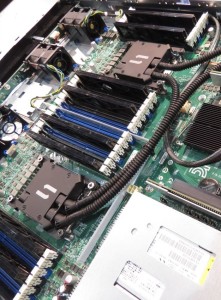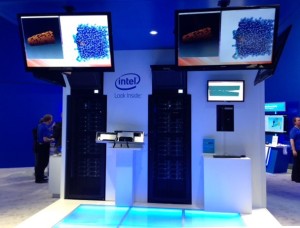The art of data center cooling is one of continuous improvement that has seen interesting innovation over the past 5 years or so. Even with improvements in the technology, the general principles are consistent; use chilled water to cool air and then strategically move this newly chilled air to hot spots within the data center. This process involves expensive chilling and air movement techniques that, on average, add up to 50% of traditional data center operating costs. The question is, if liquid is 3,500 times better at storing and transferring heat than air, why are we not moving liquid closer to the heat generating components? Would a close-coupled liquid cooling approach not remove the difficult and inefficient task of porting air to hot spots?
The Liquid Touch
Direct contact liquid cooling (DCLC) uses the exceptional thermal conductivity of liquid to provide dense, concentrated cooling to targeted small surface areas. By using DCLC, the dependence on fans and expensive air conditioning and air handling systems is drastically reduced. This enables over 45kW densities per rack using warm-water cooling, reduced power use and access to significantly higher performance potential.
Why choose liquid cooling?
- Liquid is controllable – Liquid cooling can be channeled to the specific areas in a server that produce heat. Applying cooling directly to critical components such as processors and memory drives maximum efficiency, density and performance.
- Liquid lowers operating costs –Operating expenses are decreased by 25%-30% due to reduced reliance on expensive traditional cooling infrastructure such as chillers, CRAC’s, CRAH’s, and raised-floor environments. Furthermore, the increased power density allowed by warm-water DCLC reduces the data center footprint and all associated costs (building, racks, cabling, etc.) (The average ROI for DCLC is less than six months.
- Increased rack utilization – Warm-water DCLC allows for a meaningful improvement in rack utilization. By eliminating traditional air cooling limitations such as hot spots a rack can be used to its capacity.
- Flexibility – DCLC design accommodates a variety of server design, rack architecture and data center environments, making for a pain-free upgrade. DCLC allows data center managers to transition to new liquid cooled solutions in stages – adding units to match the addition of new HPC systems and avoiding the costs associated with deploying unneeded cooling infrastructure.
Reliable Technology
CoolIT’s Rack DCLC™ technology is a cost effective, scalable and flexible DCLCsolution. The Rack DCLC™ family of solutions supports all the cooling requirements of the modern, ultra-high density HPC data center crammed with blade and other multinode chassis servers.
- Density – Rack DCLC allows for dramatic increases in server densities
- Efficiency – Rack DCLC provides a significant reduction in total data center energy used and allows for meaningful improvement in PUE
- Performance – Rack DCLC facilitates the use of many high power processors in less space.
 CoolIT’s Rack DCLC solutions are available in two heat exchange configurations. The Rack DCLC CHx™ line of products uses facility water to deliver the ultimate package in efficiency, density and performance for today’s HPC data centers. The Rack DCLC AHx™ solutions use a liquid circuit local to a rack to provide peak performance and density in a standard data center without the need for facility water supply.
CoolIT’s Rack DCLC solutions are available in two heat exchange configurations. The Rack DCLC CHx™ line of products uses facility water to deliver the ultimate package in efficiency, density and performance for today’s HPC data centers. The Rack DCLC AHx™ solutions use a liquid circuit local to a rack to provide peak performance and density in a standard data center without the need for facility water supply.
At the heart of both configurations are redundant, centralized pumping assemblies that ensure reliable cooling performance in a flexible design that supports a wide variety of server modules.
The bottom line:
- An 80% increase in rack capacity
- Increased CPU/GPU density with higher performance per core
- Over 25% decrease in CAPEX
- Over 25% decrease in OPEX
- Enables 40+kW per rack with warm water cooling
- Reduces or eliminates the need for chillers,CRAC’s, CRAH’s and raise-floor
Rack DCLC at Work
CoolIT’s Rack DCLC technology has been put to work in a variety of collaborative efforts.
 CoolIT recently teamed up with Intel and Supermicro to create an innovative HPC cluster that ranked 400 on the Top500 list of supercomputers and an impressive #41 on the Green 500 list. The cluster uses CoolIT’s Rack DCLC AHx solution and Supermicro’s ultra-dense FatTwin server platform, featuring 9936 cores with a peak performance of 131.2 teraflops. The system consumed a total of 74.25kW of power even though each Supermicro FatTwin node featured dual Intel Xeon processors and three Intel Xeon Phi coprocessors that were generating over 1,000 watts of heat per node.
CoolIT recently teamed up with Intel and Supermicro to create an innovative HPC cluster that ranked 400 on the Top500 list of supercomputers and an impressive #41 on the Green 500 list. The cluster uses CoolIT’s Rack DCLC AHx solution and Supermicro’s ultra-dense FatTwin server platform, featuring 9936 cores with a peak performance of 131.2 teraflops. The system consumed a total of 74.25kW of power even though each Supermicro FatTwin node featured dual Intel Xeon processors and three Intel Xeon Phi coprocessors that were generating over 1,000 watts of heat per node.
A collaboration between CoolIT Systems and the University of Leeds has been set up to analyse the influence of direct liquid cooling on demand within cloud based workload algorithms. The 45U Rack DCLC has been installed at the university to enhance their research into energy efficient aspects of data centers, by combining the expertise from two disciplines to understand the intersection of cloud scheduling algorithms with a fine controlled cooling on demand methodology.
CoolIT supports a wide variety of private, government, and academic organizations with their various compute initiatives. CoolIT has established itself as an experienced innovator in developing safe and reliable DCLC solutions for today’s most demanding data center users.



























































